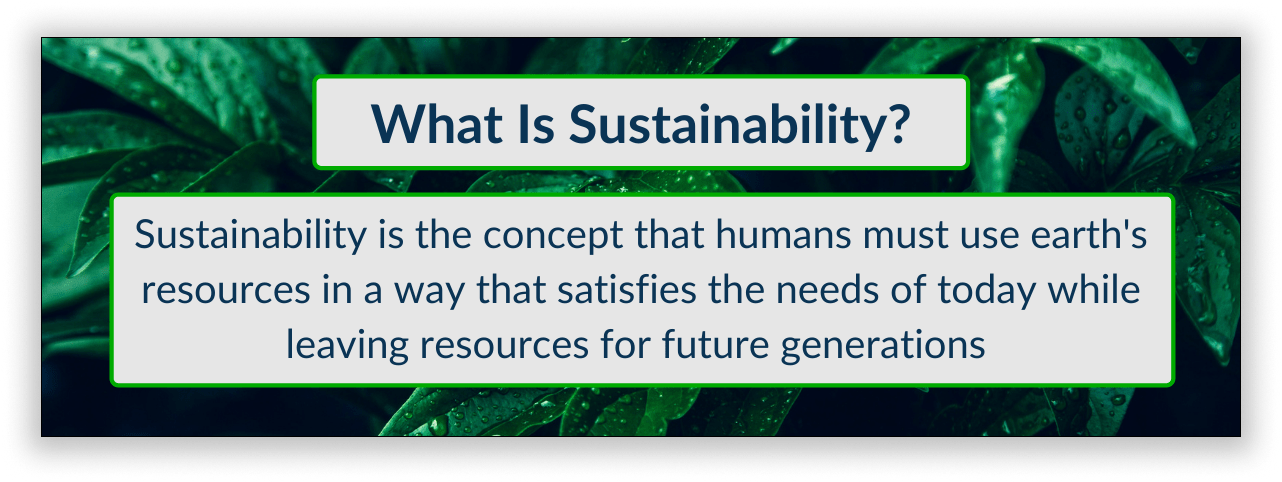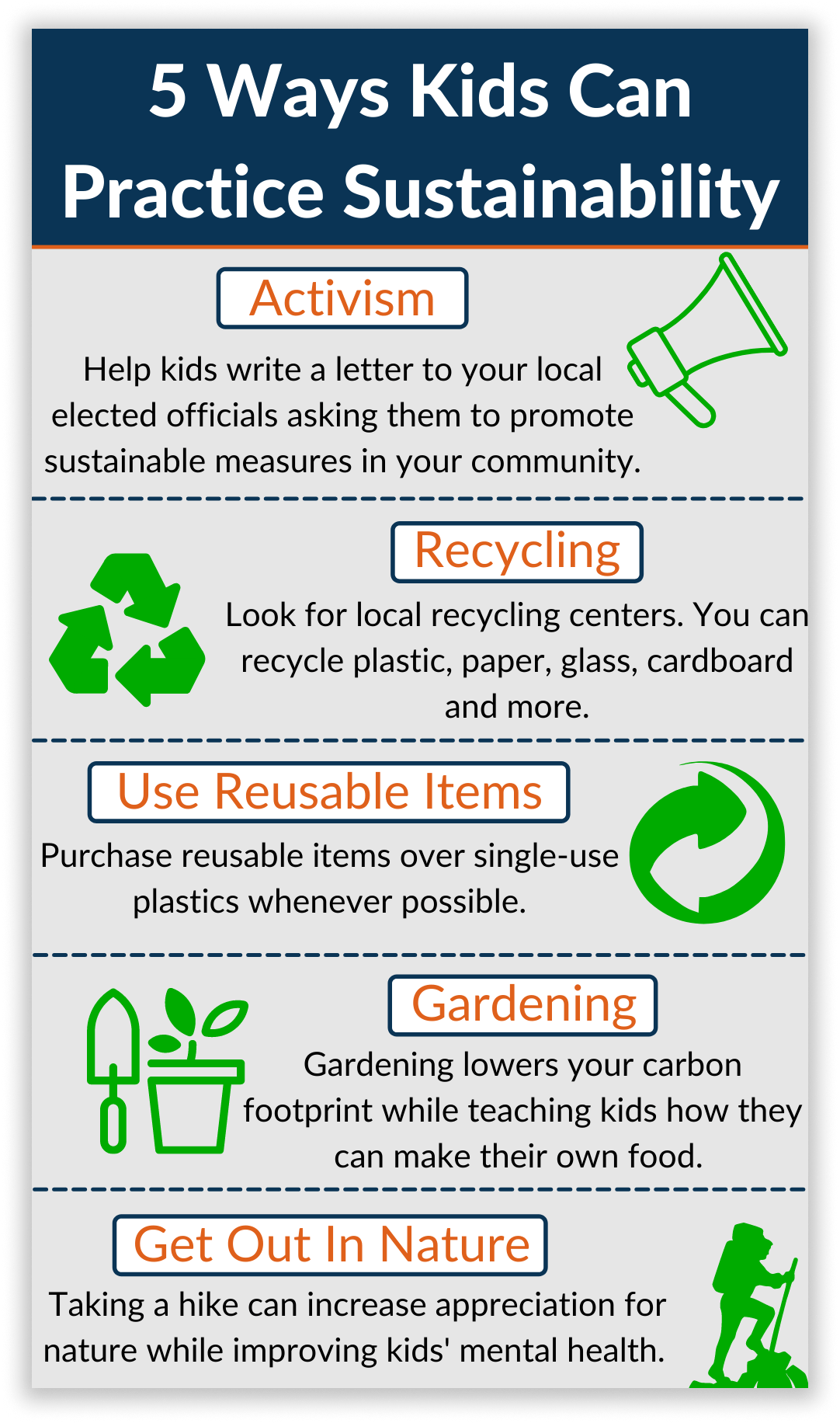The browser you are using is not supported. Please consider using a modern browser.

Teaching Sustainability to Kids
In a world where a resource-hungry population is increasing, instilling the importance of sustainability into today’s children is more important than ever.
Topics like sustainability and climate change can be daunting topics for kids. Explaining concepts in clear and simple ways, and actually having kids practice sustainability, can help them understand it and feel good about their contribution to a better world.
However, in order to do this, you must understand sustainability yourself.
Table of Contents

What Is Sustainability?

Sustainability is the concept that humans must use the earth’s resources in a way that satisfies the needs of today while leaving resources for future generations.
Earth has a finite amount of resources, and as our population continues to grow, we are putting more strain on those resources than ever. To ensure we can reach that goal of satisfying the needs of today and tomorrow, we must be able to satisfy those needs with less resources.
Talking To Kids About Sustainability
Of course, the section above is a sort of broad and vague definition of sustainability. That’s why it’s helpful to use real-world examples that can put it in context.
When using real-world examples for kids, it’s important to…
- Keep It Simple – No need to get too into the weeds. Overcomplexity can be overwhelming for anyone, but especially for kids, and they may lose the point.
- Use Multiple Examples – This shows the scope of the sustainability issues we face, and how every aspect of modern life is tied to them.
However, just explaining the situation is not enough. After showcasing the scope of the problem, you can discuss all the different ways that we can take action. This not only instills sustainable habits but also helps the kids feel good about the steps they can take to do their part.
Sustainability Topics & Examples
Here are some basic examples you can use to further explain sustainability and its importance. These examples are framed with both the problem and potential solutions that can help. Illustrating it this way underscores the fact that we can work together to solve these issues.
Energy Consumption
Problem:
Much of modern life is powered by fossil fuels, from cars to heat to electricity. The problem is that fossil fuels like oil, coal and natural gas release carbon dioxide into the atmosphere, contributing to climate change.
Because climate change causes more extreme weather like droughts and floods, this puts further stress on the resources we use every day, making our sustainability issues worse.
Plus, fossil fuels are non-renewable. This means that when we use them, they are essentially gone forever. So if we keep using them, we will eventually not have enough resources to generate the energy we need.
Potential Solutions That Can Help:
- Use Renewable Energy – We can generate our energy through renewable resources like hydropower, wind and solar energy. Renewable resources don’t release harmful greenhouse gasses into the atmosphere. And since these resources use flowing water, the sun and wind, they are practically infinite.
- Increase Energy Efficiency – Another part of the solution is increasing the energy efficiency of our homes and buildings. This will help us use less energy, which in turn, releases less carbon dioxide into the atmosphere.
Plastic Waste
Problem:
Plastic is an incredibly useful material because it’s cheap and extremely durable. However, because it’s cheap, we produce a lot of it. It’s estimated that more than 8.3 billion tons of plastic has been created since the early 1950s. And because it’s so durable, the Earth takes up to 1,000 years to break it down. That’s why more than half of that 8.3 billion tons is currently in landfills or the natural environment.
Plastic waste is a major cause of ocean pollution and can be extremely damaging to wildlife and their habitats. Fish and other wildlife can eat or get entangled in this plastic, which can cause serious harm or death. Because humans are interdependent on these ocean ecosystems, this damage can have impacts on us as well.
Potential Solutions That Can Help:
- Eliminate Single-Use Plastics – Single-use plastics are one of the largest contributors to plastic waste. These are things like water bottles, grocery bags and food packaging. Eliminating single-use plastics wherever possible could help cut back on plastic waste.
- Recycle – Recycling plastics when we dispose of them can allow us to reuse the plastic for something else, instead of it ending up in a landfill.
Water Consumption
Problem:
While the Earth’s surface is 70% water, only 3% of that water is freshwater. This is the water that we use to drink, cook, farm and more. Unfortunately, much of the world does not have access to clean water, and our wasteful use of water is making the problem worse.
For example, agriculture is responsible for 70% of water withdrawals. However, 60% of this is wasted because of poor farming practices. This dries up lakes and river beds, damaging the environment and leaving less clean water for people who need it.
Potential Solutions That Can Help:
- Use Sustainable Farming Techniques – Sustainable farming techniques are a great way to reduce pressure on the global water supply. One of the best ways to do this is to grow crops in an environment that can support those crops. This way, they won’t need to withdrawal as much water to produce them.
5 Ways Kids Can Practice Sustainability
After talking about the problem, it’s also a good idea to take action in whatever way you can.
When doing this, you should emphasize collaboration. These are large problems that governments, corporations and individuals must come together to solve. To highlight this point, it is great to get kids working together, and with other people.

Activism
As we just said, creating a sustainable and equitable world will require cooperation between governments, corporations and individuals. This makes activism a great way to get kids involved and make an impact.
You don’t have to go protest in front of the White House for this to work. It can be as simple as having the kids write a letter to their local officials, asking them to take measures to promote sustainability in their community through a new recycling program. On top of creating a more sustainable environment, this shows kids that they have a voice in their democracy.
Recycling
Recycling is a great and easy way for kids to get involved in sustainable practices. And you can recycle a lot more than just plastic:
- Aluminum
- Cardboard
- Paper
- Glass
- Electronics
- Refrigerators
- Air Conditioners
Even if your local city does not provide a recycling service, a quick google search can usually point you to a recycling center in your area. There are even some places that will pay you to recycle certain materials, which can provide an extra incentive for kids.
Use Reusable Items
Emphasize the importance of reusable items whenever possible, especially when it comes to single-use plastic. For example, you can have them use reusable water bottles instead of purchasing plastic ones.
Gardening
The food that you buy in a grocery store can not only be produced with unsustainable farming practices, but can also have a large carbon footprint. This is because food is transferred by ship, train and truck, which all use fossil fuels for power.
Gardening is a much more sustainable method of getting some of your food. It not only teaches kids how to grow their own food, but it can also boost their mood and have a positive impact on mental health. And if it’s done with other people, gardening can help foster a sense of community.
Get Out in Nature
Going out for a hike in the natural world can increase kids’ appreciation for nature, and like gardening, can do wonders for their mental health.
Before you go out, look for information on local plants and animals you may see in your area. Looking for them while you’re out on a hike is a great way to get the kids involved in their surroundings.